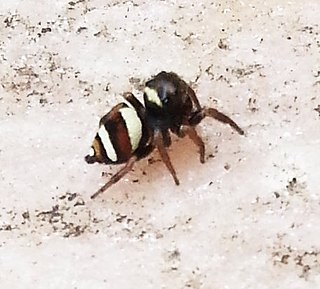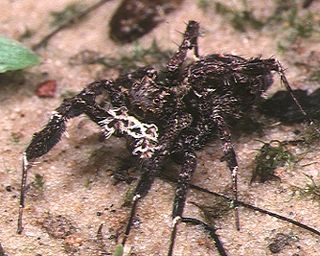
Myrmarachne is a genus of ant-mimicking jumping spiders that was first described by W. S. MacLeay in 1839. They are commonly called antmimicking spiders, but they are not the only spiders that have this attribute. The name is a combination of Ancient Greek μύρμηξ (myrmex), meaning "ant", and ἀράχνη (arachne), meaning "spider".
Bathippus is a genus of jumping spiders.

Carrhotus is a genus of jumping spiders that was first described by Tamerlan Thorell in 1891. The name is derived from the Greek Κάῤῥωτος.
Colyttus is a genus of Asian jumping spiders that was first described by Tamerlan Thorell in 1891. It is named for the Latin word for "with two stripes". C. lehtinen is named in honor of Finnish arachnologist Pekka T. Lehtinen.

Epeus is a genus of the spider family Salticidae. They are often found on broad-leaved plants or shrubs of rain forest, or in gardens of Southeast Asia.

Pancorius is a genus of Asian jumping spiders that was first described by Eugène Louis Simon in 1902. They are similar to Hyllus.
Pristobaeus is a genus of jumping spiders that was first described by Eugène Louis Simon in 1902.

Ptocasius is a genus of Asian jumping spiders that was first described by Eugène Louis Simon in 1885.

Telamonia is a genus of jumping spiders that was first described by Tamerlan Thorell in 1887. They are colorful spiders, with patterns that vary considerably between sexes and species. Two longitudinal stripes along the abdomen are common, and the carapace is often colored. They have a slender opisthosoma and long legs.

Thiania is a genus of jumping spiders that was first described by Carl Ludwig Koch in 1846.

The Spartaeinae are a subfamily of the spider family Salticidae. The subfamily was established by Fred R. Wanless in 1984 to include the groups Boetheae, Cocaleae, Lineae, Codeteae and Cyrbeae, which in turn were defined by Eugène Simon.

Euophryini is a tribe of jumping spiders. It has also been treated as the subfamily Euophryinae.
Psechrus is a genus of cribellate araneomorph spiders in the family Psechridae, and was first described by Tamerlan Thorell in 1878.
Epidius is a genus of crab spiders that was first described by Tamerlan Thorell in 1877. It is a senior synonym of Pothaeus.
Chinophrys is a genus of jumping spiders that was first described by J. X. Zhang & Wayne Paul Maddison in 2012.
Foliabitus is a genus of Asian jumping spiders that was first described by J. X. Zhang & Wayne Paul Maddison in 2012. As of June 2019 it contains only two species, found only in Asia: F. longzhou and F. scutigerus.
Parvattus is a monotypic genus of Chinese jumping spiders containing the single species, Parvattus zhui. It was first described by J. X. Zhang & Wayne Paul Maddison in 2012, and is only found in China.
Orcevia is a genus of Asian jumping spiders that was first described by Tamerlan Thorell in 1890. It was once considered a synonym of Laufeia, but it was revalidated in 2019.








